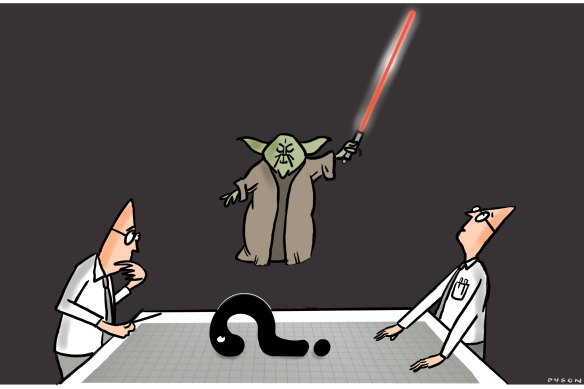Save articles for later
Add articles to your saved list and come back to them any time.
Of the great economists who have deepened our understanding of the economy and how it works, not enough attention is given to Yoda.
You might know him as a Jedi master, a great teacher who speaks with an unusual object, subject, verb pattern or as the only resident of Dagobah. But one of his insights should be considered by those clamouring for change to the stage three personal income tax cuts: “Do or do not. There is no try.”
Those on the Left are demanding an end to stage three – expected to cost at least $254 billion over the next decade including $21 billion in 2024-25 – while plenty of centrist economists have said the cuts need to be re-shaped to deliver more assistance to middle and low-income earners.
On the Right, the demand is for Treasurer Jim Chalmers to honour a plan that was hatched when Donald Trump was in the White House, people had never contemplated hoarding toilet rolls and Bill Shorten was on track to be our next prime minister.
In other words, times have changed. Yet, the argument around tax is being shaped as a simple binary choice.
What has not changed, and where Yoda’s creed comes in, is that the stage three tax cuts were limited in their ambition. They were really only about rewarding high-income earners for being denied the immediate tax relief provided in stages one and two to low-income earners.
It’s time for some Yodaconomics.Credit: Andrew Dyson
Their original author, Scott Morrison, and his successor, Josh Frydenberg, claimed the cuts were all about ending bracket creep. That’s been disproved – just last week, Australian National University economist Ben Phillips reported middle-income earners will actually be $172 worse off after stage three kicks in compared to where they were in 2018.
The non-Jedi economists at Deloitte Access Economics reckon the problem is that both supporters and critics of the stage three tax cuts aren’t thinking big enough. They argue the tax cuts should be made larger – much larger – to force the federal parliament into dealing with the increasingly broken tax system. Deloitte believes tax cuts to workers’ income should be increased by $175 billion.
Before you spit blue milk over your morning Space Pops, bear with me.
Under Deloitte’s idea, these tax cuts would skew heavily towards low-income earners. The current stage three cuts go to people earning more than $45,000. The 37 per cent tax bracket is abolished, the 32.5 per cent rate is reduced to 30 per cent and the starting point for the 45 per cent rate is pushed up to $200,000.
Deloitte suggests that the current $18,200 tax-free threshold be increased to $30,000. On their numbers, a person earning $30,000 would get a $2200 a year tax cut. That’s about a 7.5 per cent saving.
That $2200 is the best anyone can get under the proposal. For people earning $45,000 or above, the benefit from Deloitte’s idea is a flat $592 (their gains are limited to $592 because, while they benefit from the much higher tax-free threshold, the tax rate on income between $30,000 and $45,000 goes up from 19 cents in the dollar to 30 cents). So, a person earning $200,000 gets a boost worth 0.3 per cent of their income.
By any measure, this idea delivers far more bang to the bucks of a person earning less than the minimum wage.
How the hell are we going to pay for this? Deloitte has an answer. It reckons that by cutting so much revenue out of the budget, the government would have to consider real tax reform. The two largest reforms proposed by Deloitte – lifting the GST rate to 15 per cent from 10 per cent (while broadening its reach to fresh food and education) and cutting the capital gains tax concession to 33 per cent from 50 per cent – would deliver a major revenue windfall.
Deloitte estimates the higher GST rate would raise almost $500 billion in revenue. The capital gains tax change would bring in a “modest” $32.3 billion. (To get around the issue of all GST going to the states, they would be entitled to the extra tax earned from extending it to fresh food and education. Canberra would get the 5 percentage point increase in the overall rate, which it could then use to compensate low-income earners and those on welfare.)
Over a decade, the tax changes would raise a net $354 billion, bring the budget close to surplus and deliver desperately needed reform to the tax system. In its first full year, the budget would be almost $30 billion better off.
Chalmers’ budget last week confirmed the proportion of federal government tax revenue paid out of workers’ income will stay above 50 per cent for the rest of the decade. That’s only occurred on two previous occasions – in 1999-2000 and the late 1980s. In both 1988 and 2000, the then-federal government slashed income tax rates. In both cases, major tax reforms were delivered by the Hawke and Howard governments that shifted tax off workers’ incomes to other sources.
The financial demands on the federal government are growing. We got a glimpse of that in last week’s budget around properly paying aged care workers, defending the nation and caring for our most vulnerable.
At the moment, the arguments around stage three and tax in general is that you can either tax everyone much, much more (without any thought to how that might affect the economy) or you can slash government spending (without any thought to how that might affect everyone).
Deloitte’s proposals may not be the solution to Australia’s tax problems, but they prove there are alternatives that have to be examined. We can’t just try. We must do.
The Opinion newsletter is a weekly wrap of views that will challenge, champion and inform your own. Sign up here.
Most Viewed in Politics
From our partners
Source: Read Full Article








